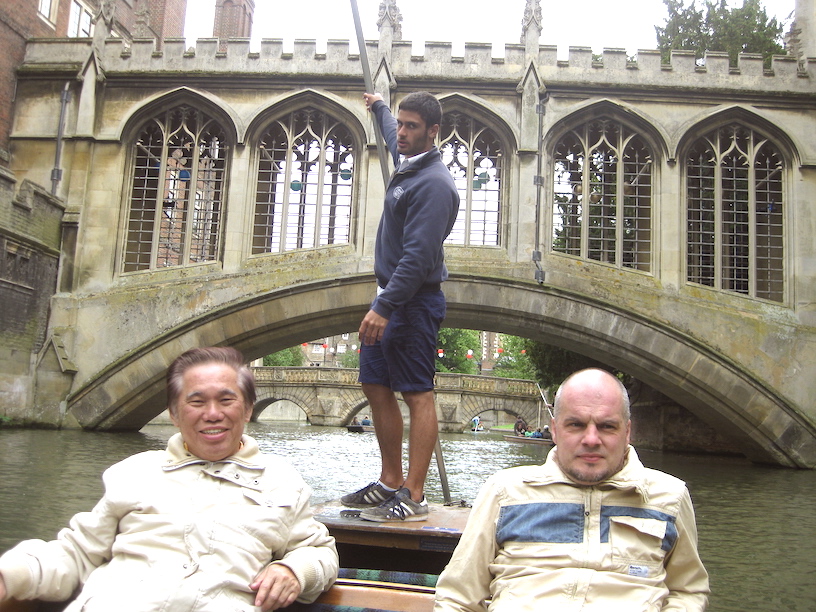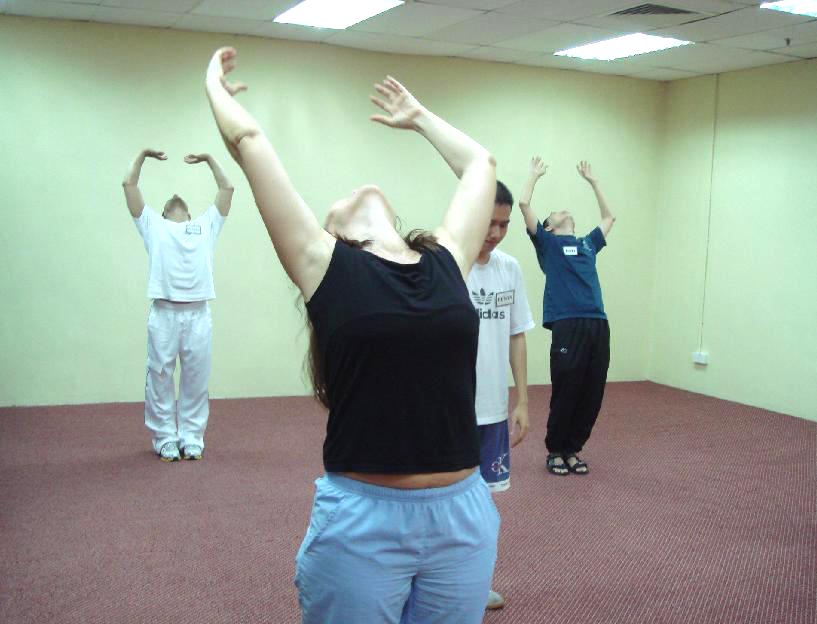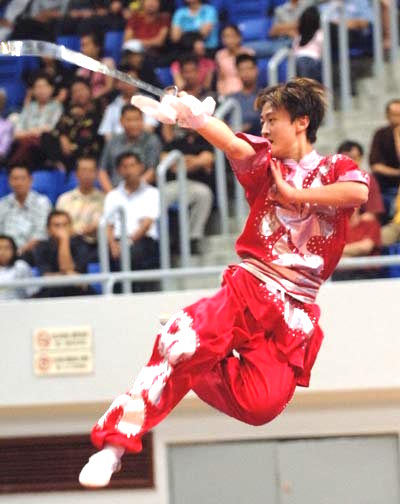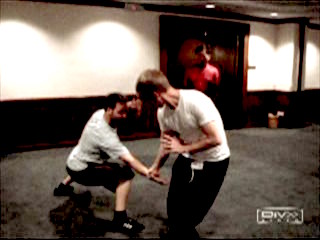SELECTION OF QUESTIONS AND ANSWERS
NOVEMBER 2010 PART 3

A picture of health and vitality - by practicing our Shaolin Wahnam arts, Grandmaster Wong and Sifu Mark Appleford are healthier and have more vitality than most people half their age
Question 1
I have heard that Sifu Wong teaches on a regular basis in Maylasia. Is there a way to study qigong (chi kung) with Sifu Wong on an ongoing basis?
— Thomas, Belgium
Answer
I used to teach on a regular basis in the past, but not now. Now I teach regional courses in various parts of the world, and intensive courses in Malaysia.
These regional and intensive courses last only a few days each. Please see my website for details of these courses. I offer about two or three Intensive Chi Kung Courses a year.
It is understandable that many people wonder whether they could learn enough in a three-day intensive course. It may be unbelieable or sound boastful to many people, but it is true that students learn more in a few days in my Intensive Chi Kung Course than many people learn in many years in regular classes.
For example in my Intensive Chi Kung Course, students learn how to tap energy from the Cosmos, generate an energy flow, and develop internal force. Very few people learn these important chi kung skills even when they have practiced chi kung for many years.
Question 2
I am dealing with some health issues and understand that Sifu is emphasizing this aspect lately.
Answer
Yes, you are right. Overcoming pain and illness, and attending good health and vitality are the two fundamental aims of my chi kung courses. Even in our Shaolin Kungfu and Wahnam Taijiquan courses, we give priority to attaining good health over combat efficiency.
But please bear in mind that your pain and illness are unlikely to be overcome at the course itself. You need to continue to practice what you have learnt in the course. Many students overcome their pain and illness after a few months of daily practice.

Participants of an Intensive Chi Kung Course practicing "Carrying the Moon". To the uninitiated, it is difficult to tell the difference between genuine chi kung and gentle physical exercise by merely looking at the forms
Question 3
Who would be the contact person to discuss logistics and costs? Email would be fine.
Answer
Please contact my secretary by e-mail at secretary@shaolin.org.
Question 4
I am very intersted to do chi kung sport. I wish to be a sifu now.
— Endrias, Ethiopia
Answer
Chi kung is not a sport. It is a serious art that demands much time and effort, though it is also full of fun besides giving practitioners many benefits.
You cannot become a sifu, or teacher, just by wishing. First of all you need to be a good student.
You also need to ensure that you learn and practice genuine chi kung and not merely gentle physical exercise. Indeed, many students today merely practice gentle physical exercise though they mistakenly think it is chi kung and they are unaware of it.
The difference between genuine chi kung and gentle physical exercise is not in the forms. Both look alike. The difference is in their practice and benefits. In genuine chi kung a practitioner works on energy, whereas in gentle physical exercise a practitioner works on his physical body, like joints and muscles. Though one may not be actually aware of this fact, if he does not know what working on energy is, it is obvious that he is not practicing chi kung, just as if he does not know what kicking a football is, it is obvious he is not playing football.
There are many different benefits between genuine chi kung and gentle physical exercise. In genuine chi kung, a practitioner has more energy at the end of his practice than before, whereas in gentle physical exercise he has less energy. Practicing genuine chi kung overcomes pain and illness, but practicing gentle physical exercise does not.
Practicing genuine chi kung works on the mind and spirit. A chi kung practitioner has more mental clarity and become peaceful and happy. Practicing physical exercise overworks the mind and spirit. After doing physical exercise a practitioner is mentally more tired and spiritually more stressful than before the exercise. He usually has to rest for some time, often called cooling down, before he returns to normal.

A beautiful wushu demonstration culled from
http://en.beijing2008.cn/goodluckbj/wushu/n214200778.shtml.
Moden wushu is different from traditional kungfu.
Question 5
Please help me by attaching videos and practical work with examples.
Answer
Like many people, you have a mistaken idea of what chi kung is. My book, The Art of Chi Kung, will give you a good explanation.
There are many videos on my website. Unless you are already well versed in chi kung, learning it from videos is inadequate to give you good benefits. You have to learn it from a living teacher.
Question 6
I am also learning kungfu. I love this Chinese sport very much.
Answer
Kungfu is not a sport. It is a serious martial art. But today kungfu is practiced as a sport in China, and is popularly called "wushu".

Sifu Roland of Switzerland and Sifu Nick of England using Monkey Kungfu in their sparring
Question 7
I am just beginning my fourth year of study of Choy Lay Fut kung fu under my sifu in the UK. I am also deeply interested in the southern Shaolin Monkey style, which I believe is written in English as "Nan Hou Quan."
I have been unable to find any masters teaching this style in Britain, and so far I have had no luck trying to locate masters over the internet. I have found plenty of pages on the Tai Shing Pek Kwar Moon in Hong Kong, but next to nothing on the Shaolin Monkey art. I have read of many styles that have one or two monkey patterns, but the complete style has eluded me.
— Downes, UK
Answer
You are right in saying that many kungfu styles have Monkey patterns in them. Some styles also have complete Monkey sets But kungfu styles that uses Monkey kungfu as styles by themselves are rare. A rare Monkey style is Pak Yun Moon, or Bai Yun Men in Mandarin pronunciation.
Pak Yun Moon means While Monkey School. It is a northern style, and is much influenced by Lama Kungfu from Tibet.
Another Monkey style is Tai Shing Moon. "Tai Shing" means "Great Sage", and "Moon" means "school". These words are in Cantonese pronunciation. "Tai Shing" or "Great Sage" refers to the title "Great Sage Equal to Heaven" bestowed by the Heavenly Jade Emperor to the Monkey God. Hence, Tai Shing Moon refers to the Monkey Style. It is also a northern Shaolin style.
"Pek Kwar" literally means "Chop-Hang", and refers to two prominent fist techniques. Pek Kwar Moon is a northern Shaolin style too, and it frequently employs the chopping fists and hanging fists.
Tai Shing Pek Kwar Moon is a kungfu school that combines Tai Shing Style and Pek Kwar Style. Its patriarch is Sifu Chan Sao Choong of Hong Kong. His Monkey Style is so good that he is sometimes nick-named "Monkey King". Sifu Chan Sao Choong has produced some very formidable fighters who have won international sparring championships. One of them is Sifu Chan Khoon Thye who played the role of the great Shaolin master, Hoong Hei Khoon, in some Hong Kong kungfu movies in the 1960s.
Question 8
I am emailing to ask if the Wahnam Institute knows where any Nan Hou Quan masters may be found. They are starting to seem as elusive as real monkeys.
Answer
Real monkeys are plentiful if you know where to find them. But real masters of Monkey Kungfu is very rare. As mentioned above, one of these rare masters is Sifu Chan Sao Choong of Hong Kong.
Nan Hou Quan is in Mandarin pronunciation, and it means Southern Monkey Kungfu. Some masters may teach Nan Hou Quan as a set, but I do not know of Nan Hou Quan as a complete style by itself. Nevertheless, I heard about a master from Penang, Malaysia teaching the Monkey style in Europe in the 1960s. I do not know his name, and I do not know whether he called his style Nan Hou Quan.
Question 9
I have just qualified as an English teacher and I am planning to travel to China shortly to begin searching myself. As it is a large nation, I would be immensely grateful if you can give me any clues of where to start looking.
Answer
A good place to start looking is at your home. Before you set out for China, find out the difference between modern wushu and traditional kungfu.
What is taught in China today is modern wushu. What you pursue, like Choy-Li-Fatt and Monkey Style, is traditional kungfu. They are qute different, though outwardly wushu forms and kungfu forms look the same.
LINKS
Selected Reading
- Is Chi Real or Just an Illusion?
- Is there Further Training after an Intensive Course?
- There is Ground-Fighting in Shaolin Kungfu
- Applying Chin-Na on Karate Opponents
- The Legendary Shaolin Flower Set
